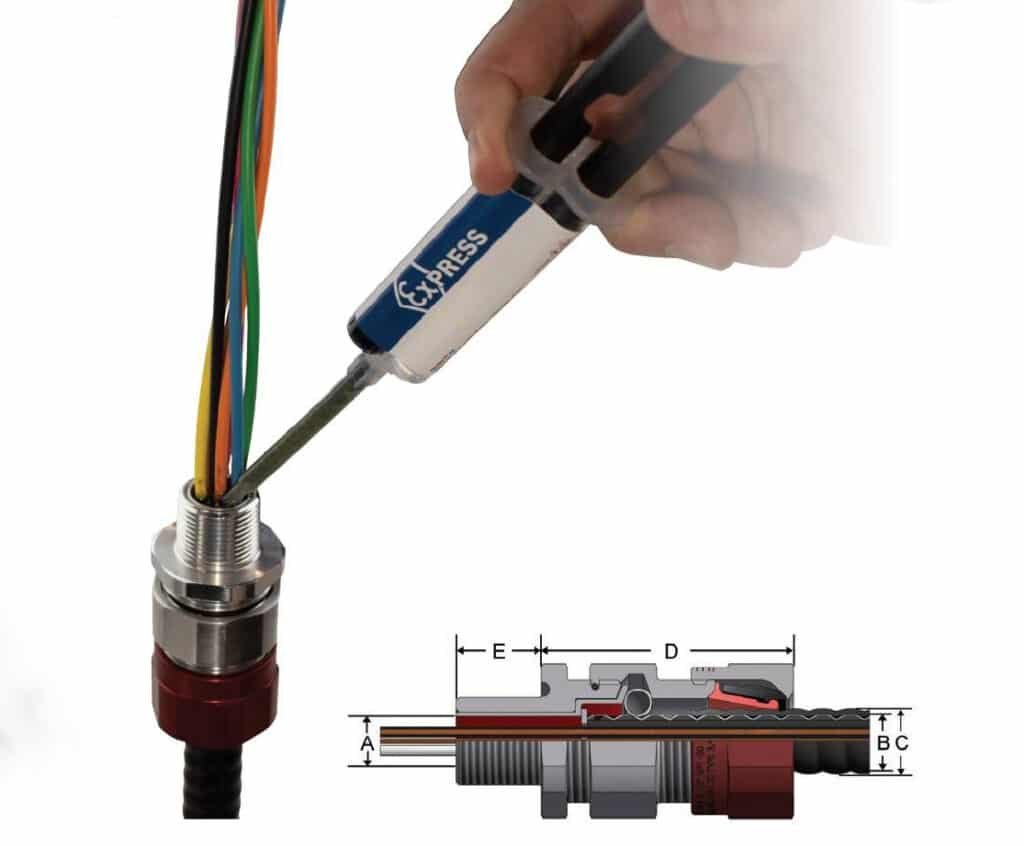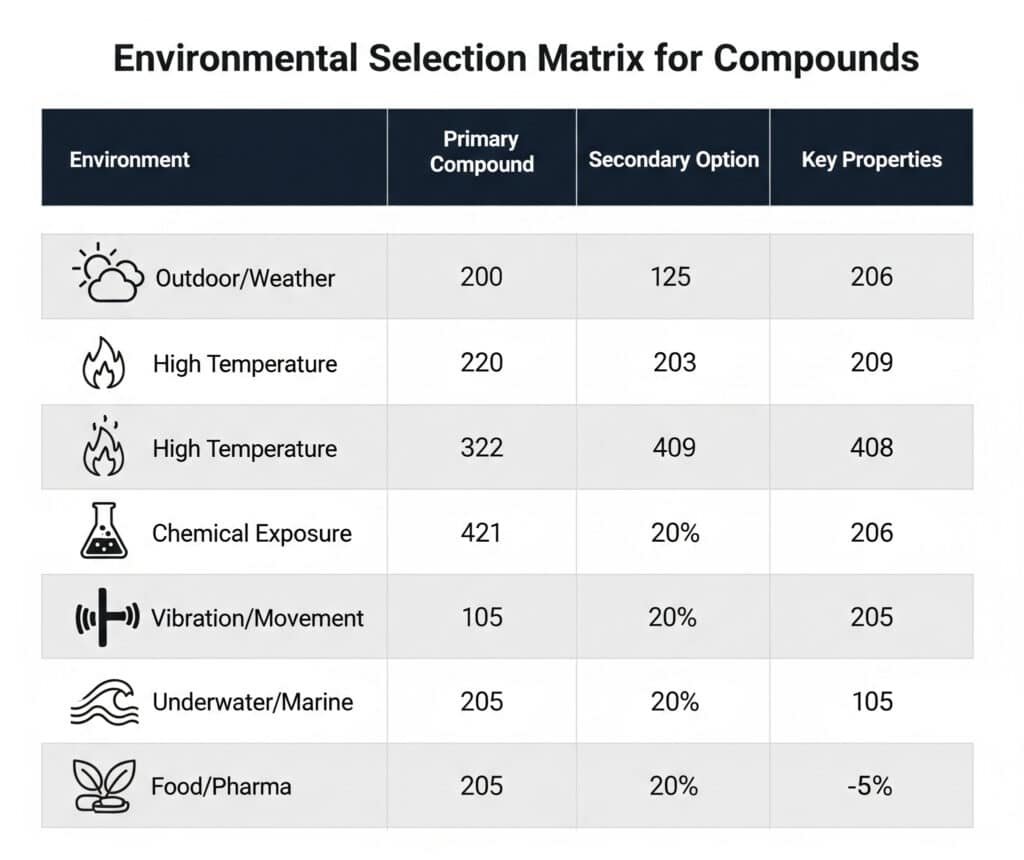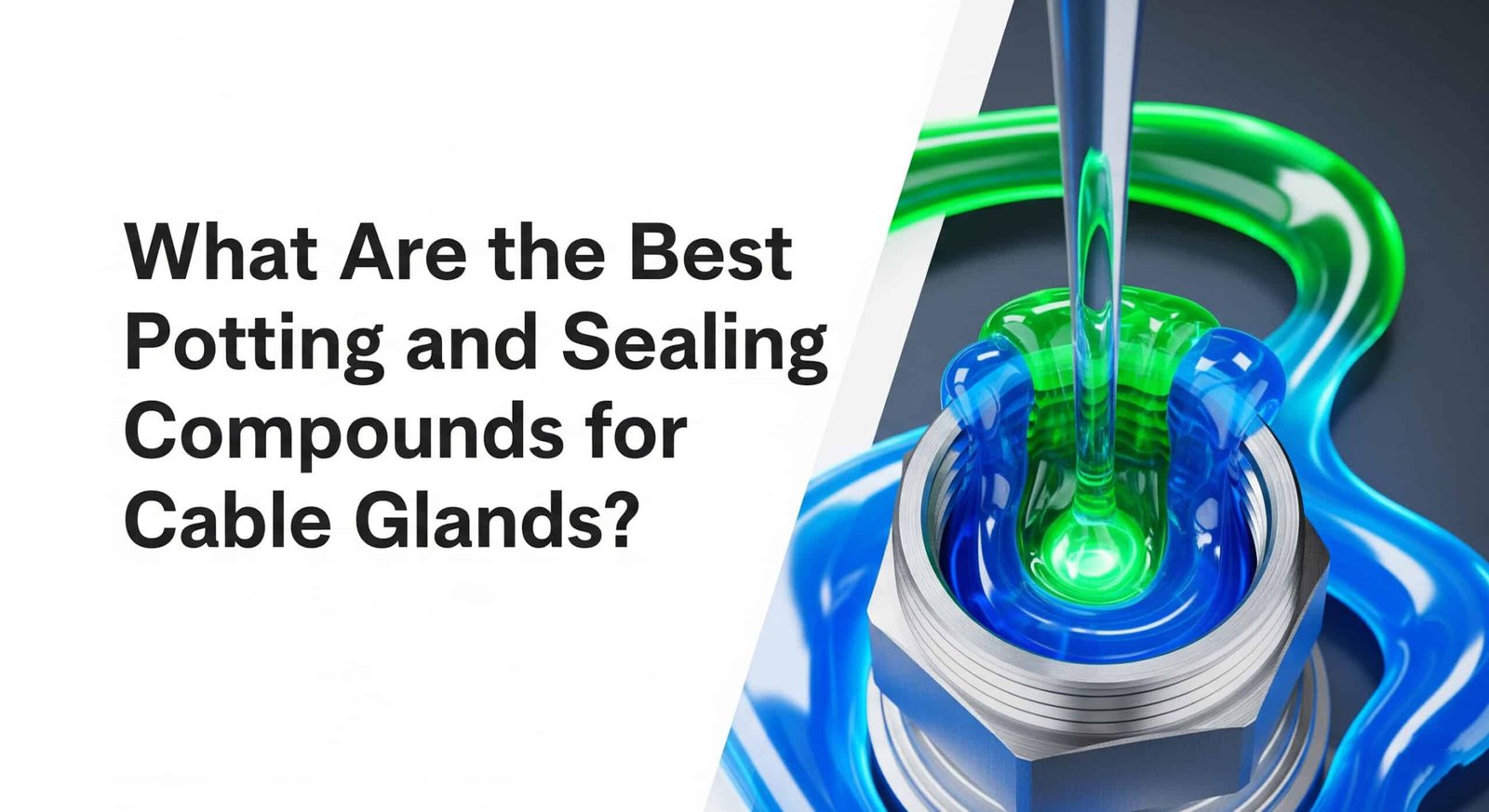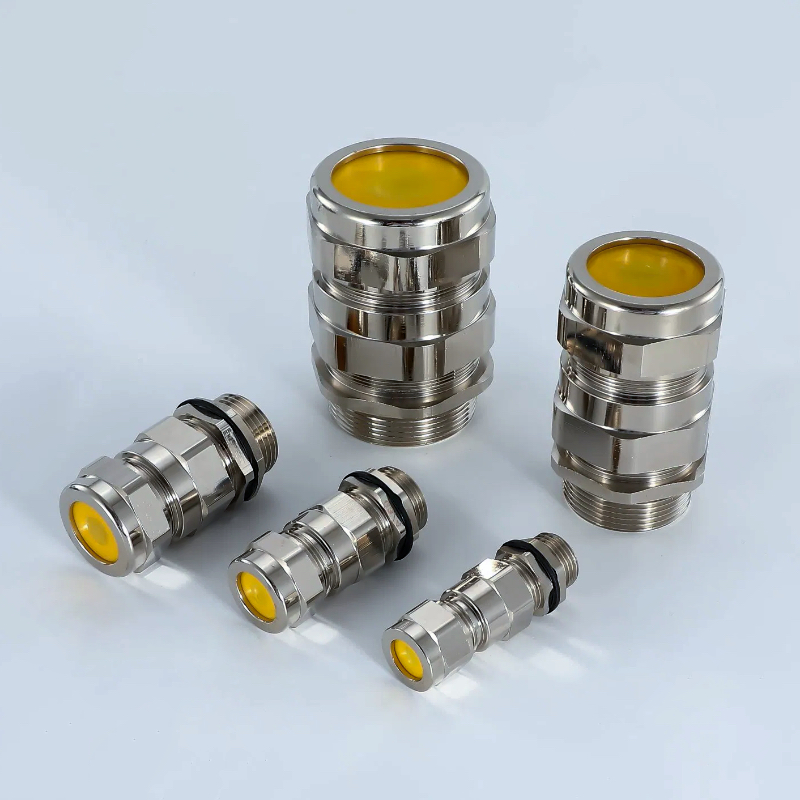Ebapiisavad tihendussegud põhjustavad kriitilistes elektrisüsteemides katastroofilisi rikkeid, võimaldades niiskuse sissetungi, mis põhjustab lühiseid, korrosiooni ja seadmete kahjustusi, mis maksavad tuhandeid remondi- ja seisakuaegu, samas kui valesti valitud segu põhjustab tihendite lagunemist, keskkonna saastumist ja ohutusriske, mis ohustavad süsteemi töökindlust. Paljud insenerid võitlevad sobivate tihendus- ja tihendussegude valimisega, valides sageli üldisi lahendusi, mis ebaõnnestuvad konkreetsetes keskkonnatingimustes või keemilise kokkupuute korral.
Parimad potting- ja tihendusmaterjalid kaablipaigaldiste jaoks sõltuvad keskkonnatingimustest, temperatuurivahemikest ja keemilisest kokkupuutest, kusjuures silikooniühendid pakuvad suurepärast paindlikkust ja ilmastikukindlust, polüuretaan pakub parimat mehaanilist tugevust ja epoksiid pakub maksimaalset keemilist vastupidavust, mis nõuab nõuetekohast valikut vastavalt konkreetsetele rakendusnõuetele, et tagada pikaajaline tihendusvõime. Edu sõltub ühendite omaduste vastavusest tegelikele kasutustingimustele.
Olles töötanud koos hooldusmeeskondadega Šveitsi ravimitehastes, avamereplatvormidel Põhjameres ja autotööstuses Lõuna-Koreas, olen õppinud, et õige tihendusmaterjalide valik võib olla vahe usaldusväärse toimimise ja kulukate süsteemirikete vahel. Lubage mul jagada olulisi teadmisi, kuidas valida ja rakendada õigeid segusid teie kaablifiltrite rakenduste jaoks.
Sisukord
- Millised on saadaolevad pottimis- ja tihendusmaterjalid?
- Kuidas valida ühendid keskkonnatingimuste alusel?
- Millised on erinevate ühendite õiged pealekandmistehnikad?
- Kuidas tagada pikaajaline jõudlus ja hooldus?
- Millised on tavalised vead ja kuidas neid vältida?
- Korduma kippuvate ja tihendavate ühendite kohta
Millised on saadaolevad pottimis- ja tihendusmaterjalid?
Saadaval on silikoonipõhised materjalid paindlikkuse ja ilmastikukindluse tagamiseks, polüuretaaniühendid mehaanilise tugevuse ja kulumiskindluse tagamiseks, epoksüvaigud keemilise vastupidavuse ja struktuurilise terviklikkuse tagamiseks ning spetsiaalsed ühendid, nagu polüsulfiid ja butüülkummi, mis on mõeldud konkreetsete keskkonnaprobleemide lahendamiseks, kusjuures igaühel neist on ainulaadsed omadused, mis sobivad erinevatele kaablipaigaldiste rakendustele.
Ühenditüüpide mõistmine on oluline, sest igal materjalil on erinevad eelised ja piirangud, mis muudavad need sobivaks konkreetsete rakenduste ja keskkondade jaoks.

Silikoonipõhised ühendid
RTV silikoon: Toatemperatuuril vulkaniseeruv silikoon1 pakub suurepärast paindlikkust, temperatuurikindlust (-65°C kuni +200°C) ja UV-stabiilsust, mistõttu sobib see ideaalselt välitingimustes ja termilise tsüklilisusega keskkondades kasutamiseks.
Kõrgtemperatuuriline silikoon: Spetsiaalsed preparaadid taluvad temperatuuri kuni 315 °C, mis sobib kõrge kuumusega rakendusteks, näiteks mootoriruumi ja tööstusahjude jaoks.
Juhtiv silikoon: Sisaldab juhtivaid täiteaineid EMI-varjestuse rakenduste jaoks, tagades nii tihendamise kui ka elektromagnetilise ühilduvuse tundlikes elektroonikakeskkondades.
Põlemiskindel silikoon: UL94 V-0 hinnatud2 preparaadid vastavad tuleohutusnõuetele hoonete ja transpordirakenduste elektripaigaldiste puhul.
Polüuretaani ühendid
Kahekomponentne polüuretaan: Pakub suurepäraseid mehaanilisi omadusi, keemilist vastupidavust ja haardumist erinevate aluspindadega, ideaalne struktuurilist terviklikkust nõudvate rakenduste jaoks.
Niiskuskinnitusega polüuretaan: Ühekomponentsed süsteemid, mis kõvenevad õhuniiskuse mõjul, pakkudes mugavust välitöödel ja remonditöödel.
Paindlik polüuretaan: Madalamoodulilised koostised võimaldavad soojuspaisumist ja vibratsiooni, säilitades samal ajal tihendi terviklikkuse dünaamilistes rakendustes.
Keemiakindel polüuretaan: Spetsiaalsed koostised on vastupidavad spetsiifilistele kemikaalidele, nagu kütused, õlid ja lahustid, mis on tavalised tööstuskeskkondades.
Epoksüühendid
Standardne epoksü: Kahekomponentsed süsteemid, mis pakuvad suurepärast adhesiivsust, keemilist vastupidavust ja mehaanilist tugevust püsivateks tihendusteks.
Paindlik epoksü: Modifitseeritud koostised, mis on paindlikumad ja termilise löögikindlusega, säilitades samal ajal keemilise vastupidavuse omadused.
Kõrgtemperatuurne epoksü: Kuumakindlad preparaadid kuni 200 °C, mis sobivad energiatootmise ja tööstuslike protsessiseadmete jaoks.
Veealune epoksü: Spetsiaalselt veealuste rakenduste jaoks väljatöötatud, tagades usaldusväärse kõvenemise ja toimivuse märgades keskkondades.
Spetsialiseeritud ühendid
Polüsulfiidist hermeetikud: Polüsulfiidist hermeetikud3 pakuvad suurepärast kütuse- ja lahustikukindlust, mida kasutatakse tavaliselt lennundus- ja autotööstuses, kus on oodata kokkupuudet süsivesinikega.
Butüülkummiühendid: Suurepärased veeaurutõkkeomadused ja pikaajaline paindlikkus, ideaalne välitingimustes kasutamiseks.
Kuumsulavad ühendid: Termoplastilised materjalid, mida kasutatakse kuumalt kiireks tihendamiseks, mis sobivad suurte tootmismahtude jaoks.
Anaeroobsed hermeetikud: Kõveneb õhu puudumisel, sobib suurepäraselt keermestatud ühenduste ja metall-metall-tihenduste jaoks.
Kuidas valida ühendid keskkonnatingimuste alusel?
Ühendite valimiseks on vaja analüüsida temperatuurivahemikke, keemilist kokkupuudet, mehaanilisi pingeid ja keskkonnategureid, nagu UV-kiirgus ja niiskus, kusjuures silikooniühendid sobivad kõige paremini äärmuslike temperatuuride ja ilmastikutingimuste jaoks, polüuretaan mehaanilise koormuse ja kulumise jaoks, epoksü keemilise vastupidavuse jaoks ning spetsiaalsed ühendid ainulaadsete probleemide jaoks, nagu kokkupuude kütusega või veealune teenindus.
Nõuetekohane keskkonnaanalüüs on kriitilise tähtsusega, sest koostise tõrked tulenevad sageli pigem materjali sobimatutest omadustest kui rakendusvigadest.
Temperatuuriga seotud kaalutlused
Madala temperatuuriga toimivus: Silikooniühendid säilitavad paindlikkuse kuni -65°C, samas kui enamik polüuretaanidest muutuvad hapraks alla -40°C, mistõttu on materjali valik külmade kliimatingimuste puhul kriitiline.
Kõrge temperatuurikindlus: Standardsed ühendid on tavaliselt 85-125 °C, samas kui spetsiaalsed kõrge temperatuuriga preparaadid laiendavad kasutust kuni 200-315 °C äärmuslikeks rakendusteks.
Termiline tsüklilisus: Korduvate temperatuurimuutustega rakendused nõuavad madala soojuspaisumise ja suure paindlikkusega ühendeid, et vältida tihendite rikkeid.
Soojuse hajutamine: Mõned ühendid tagavad soojusjuhtivuse, mis aitab hajutada soojust elektrilistest ühendustest, mis on oluline suure voolutugevusega rakendustes.
Nõuded keemilisele vastupidavusele
Kokkupuude süsivesinikega: Kütuse- ja naftakeskkond nõuab spetsiaalseid ühendeid, nagu polüsulfiid või kemikaalikindel polüuretaan, mis ei paisu ega lagune.
Happe- ja alusekindlus: Keemilise töötlemise rakendused vajavad epoksü- või spetsiaalseid ühendeid, mis peavad vastu äärmuslikele pH väärtustele, ilma et need laguneksid.
Lahustikukindlus: Tööstuslikud puhastusvahendid võivad rünnata paljusid ühendeid, mis nõuab hoolikat valikut konkreetse keemilise kokkupuute alusel.
Oksüdeeriv keskkond: Mõned kemikaalid tekitavad oksüdeerivaid tingimusi, mis lagundavad orgaanilisi ühendeid kiiresti, mistõttu on vaja spetsiaalseid preparaate.

Mehaanilised pingetegurid
Vibratsioonikindlus: Pideva vibratsiooniga rakendused nõuavad paindlikke ühendid, mis ei pragune ega lase end tsüklilise koormuse all lahti.
Kulumiskindlus: Füüsilisele kulumisele allutatud alad vajavad vastupidavaid ühendeid, nagu polüuretaan, mis peavad vastu pinnakahjustustele.
Nõuded kleepumisele: Erinevad põhimikud vajavad usaldusväärseks liimimiseks spetsiifilisi adhesiivseid promootoreid või ühendite koostist.
Paindlikkuse vajadused: Dünaamilised rakendused nõuavad ühendid, mis säilitavad elastsuse kogu kasutustemperatuuri vahemikus.
Keskkonnaalane valiku maatriks
| Keskkond | Esmane ühend | Teisene valikuvõimalus | Peamised omadused |
|---|---|---|---|
| Väljas/ilmad | RTV silikoon | Polüuretaan | UV-kindlus, paindlikkus |
| Kõrge temperatuur | Kõrgtemperatuurne silikoon | Epoksü | Kuumakindlus, stabiilsus |
| Keemiline kokkupuude | Epoksü | Polüsulfiid | Keemiline vastupidavus |
| Vibratsioon/liikumine | Paindlik polüuretaan | Silikoon | Paindlikkus, väsimuskindlus |
| Veealune/mereline | Marine Epoxy | Silikoon | Veekindlus, kleepuvus |
| Toiduained/Farma | FDA silikoon | USP polüuretaan | Ohutushinnangud, puhastatavus |
Marcus, Šveitsis Baselis asuva farmaatsiatööstusettevõtte hooldusjuht, seisis silmitsi korduvate tihendite riketega kaablitihendites, mis puutusid kokku puhastuskemikaalide ja aurusteriliseerimistsüklitega. Tema meeskond kasutas standardseid silikooniühendeid, mis lagunesid agressiivsete keemiliste puhastusprotokollide all kiiresti, põhjustades iga 6-8 kuu tagant niiskuse sissetungi ja seadmete rikkeid. Me analüüsisime konkreetseid kemikaale ja temperatuuritsükleid ning soovitasime seejärel spetsiaalset kemikaalikindlat polüuretaaniühendit, mis on mõeldud farmaatsiatööstusrakenduste jaoks. Uus ühend saavutas üle 3 aasta usaldusväärset tööd ilma lagunemiseta, kõrvaldades kulukad hooldustsüklid ja tagades järjepideva tootmise käitusaja. Parem kemikaalikindlus vastas ka FDA nõuetele toiduainetele mõeldud tootmispiirkondades. 😊
Millised on erinevate ühendite õiged pealekandmistehnikad?
Õige pealekandmistehnika on ühenditüübiti erinev ja nõuab pinna ettevalmistamist, õigeid segamissuhteid, sobivaid kõvastumistingimusi ja kvaliteedikontrolli meetmeid, kusjuures silikooniühendid vajavad puhtaid ja kuivi pindu ning toatemperatuuril kõvastumist, polüuretaanid vajavad täpset segamist ja kontrollitud niiskust ning epoksiidid nõuavad optimaalse töö tagamiseks täpseid segamissuhteid ja nõuetekohast temperatuuri reguleerimist.
Värvimistehnika on sageli kriitilisem kui segu valik, sest isegi parimad materjalid ebaõigesti rakendatuna ebaõnnestuvad.
Pinna ettevalmistamise nõuded
Puhastusprotseduurid: Kõik pinnad peavad olema vabad õlist, mustusest, niiskusest ja oksüdeerumisest ning vajavad tavaliselt lahustiga puhastamist, millele järgneb mehaaniline hõõrumine optimaalse haardumise saavutamiseks.
Krundi pealekandmine: Paljud ühendid nõuavad konkreetsete aluspindade jaoks kruntimisvahendeid, kusjuures õige liimimise jaoks on kriitiline nende pealekandmise aeg ja paksus.
Niiskuskontroll: Enamik ühendeid on pealekandmise ajal niiskuse suhtes tundlikud, mistõttu on vaja kuiva keskkonda ja mõnikord ka aluspinna eelsoojendamist.
Temperatuuri konditsioneerimine: Enne pealekandmist peavad põhimikud ja ühendid olema õigel temperatuuril, et tagada õige viskoossus ja kõvenemisomadused.
Segamine ja pealekandmise meetodid
Kahekomponentne segu segamine: Täpne suhte kontrollimine kaalu- või mahumõõtmiste abil koos põhjaliku segamisega, et tagada ühtlased omadused kogu kasutatavas segus.
Pot Life Management: Töötamine kindlaksmääratud piires poti eluiga4 piirangud, et vältida osalist kõvenemist pealekandmise ajal, mis nõuab suurte rakenduste puhul partii suuruse planeerimist.
Rakendusvahendid: Sobivad doseerimisseadmed alates lihtsatest süstaldest väikeste rakenduste jaoks kuni automatiseeritud doseerimissüsteemideni tootmiskeskkondades.
Paksuse kontroll: Struktuurilise terviklikkuse tagamiseks vajaliku paksuse säilitamine, vältides samas liigse materjali kasutamist, mis suurendab kulusid ja kõvenemisaega.
Ravimistingimused ja kvaliteedikontroll
Temperatuuri kontroll: Õige kõvastumistemperatuuri säilitamine kogu protsessi vältel, kusjuures mõned ühendid vajavad täieliku kõvastumise saavutamiseks kõrgemat temperatuuri.
Niiskuse juhtimine: Atmosfääri niiskuse taseme kontrollimine kõvastumise ajal, mis on eriti oluline niiskustundlike ühendite, näiteks polüuretaanide puhul.
Paranemisaja kontroll: Piisava kõvenemisaja võimaldamine enne ekspluatatsiooni, kusjuures täieliku kõvenemise kontrollimiseks kasutatakse kiirendatud katsemeetodeid.
Kvaliteedikontroll: Visuaalne kontroll tühimike, nõuetekohase katvuse ja haardumise suhtes, vajaduse korral koos funktsionaalsete katsetega.
Rakenduse parimad praktikad
Silikoon Kasutamine:
- Puhastage pinnad isopropüülalkoholiga
- Kui tootja on seda ette näinud, kandke kruntvärvi.
- Tööriista pind 5-10 minuti jooksul pärast pealekandmist
- Lase 24-48 tundi toatemperatuuril kõveneda.
- Vältida saastumist küpsemisperioodi jooksul
Polüuretaani kasutamine:
- Veenduge, et pinnad on täiesti kuivad
- Segage komponendid põhjalikult poti kasutusaja jooksul
- Kanda õhukeste kihtidena, et vältida kuumuse tekkimist
- Kaitseb niiskuse eest kõvenemise ajal
- Laske enne kasutamist täielikult kõveneda
Epoksiidrakendused:
- Eelsoojendada põhimikke, kui see on soovitatav
- Parima tulemuse saavutamiseks segage täpne massiprotsent
- Töötavad kiiresti poti kasutusaja piirides
- Säilitamistemperatuuri säilitamine kogu protsessi vältel
- Järelkuivatus, kui see on ette nähtud maksimaalsete omaduste saavutamiseks
Tavalised rakendusvigad
Ebapiisav pinnatöötlus: Saastunud pinnad põhjustavad nakkevigastusi, mis on kõige levinum põhjus, miks tihendid kasutamisel ebaõnnestuvad.
Väärad segamissuhted: Segamise ebapiisav suhe põhjustab ebatäielikku kõvenemist ja halbu omadusi, mis on eriti kriitiline epoksüühendite puhul.
Keskkonna saastumine: Kokkupuude niiskuse, äärmuslike temperatuuride või saasteainetega kõvenemise ajal kahjustab lõppomadusi.
Ebapiisav küpsemisaeg: Enneaegne kokkupuude kasutustingimustega enne täielikku kõvenemist põhjustab enneaegset riket.
Kuidas tagada pikaajaline jõudlus ja hooldus?
Pikaajaline toimivus eeldab õiget ühendite valikut, õigeid kasutamisprotseduure, regulaarseid kontrolliprogramme ja planeeritud hooldusgraafikuid, kusjuures toimivuse jälgimine visuaalse kontrolli, elektriliste katsete ja keskkonnale kokkupuute hindamise abil võimaldab tuvastada kahjustusi enne rikete tekkimist ja võimaldada ennetavat hooldust.
Süstemaatilised hooldusprogrammid on olulised, sest tihendusühendite rikked tekivad sageli järk-järgult ilma ilmsete hoiatusmärkideta, kuni tekib katastroofiline rike.
Tulemuslikkuse järelevalve programmid
Visuaalse kontrolli graafikud: tihendusmaterjalide korrapärane kontrollimine pragude, värvimuutuste, kõvenemise või muude lagunemise tunnuste suhtes, mis viitavad kasutusaja lõppemisele.
Elektrikatsetused: Perioodiline isolatsioonikindlus5 ja järjepidevuse testimine, et tuvastada toimivuse halvenemine enne tihendi täieliku rikke tekkimist.
Keskkonnaseire: Jälgib kokkupuutetingimusi, nagu temperatuur, niiskus ja kemikaalidega kokkupuutumine, et ennustada järelejäänud kasutusiga.
Dokumentatsioonisüsteemid: Arvestuse pidamine ühenditüüpide, kasutamiskuupäevade ja kontrolli tulemuste kohta, et toetada hoolduse planeerimist ja ühendite valiku optimeerimist.
Ennetava hoolduse strateegiad
Plaaniline asendamine: Proaktiivne asendamine, mis põhineb pigem eeldataval kasutusajal kui rikke ootamisel, mis on eriti oluline kriitiliste rakenduste puhul.
Seisundipõhine hooldus: Väljavahetus, mis põhineb pigem tegelikul seisukorra hindamisel kui fikseeritud ajakavadel, optimeerides hoolduskulusid ja tagades samal ajal töökindluse.
Uuendamisvõimalused: Uute ühendtehnoloogiate perioodiline hindamine, mis võivad pakkuda paremaid tulemusi või pikemat kasutusiga.
Koolitusprogrammid: Tagada, et hoolduspersonal mõistab õigeid kontrollitehnikaid ja varajasi hoiatusmärke ühendite lagunemise kohta.
Tehnikad kasutusaja pikendamiseks
Keskkonnakaitse: Kaitsekatete või -katete lisamine, et vähendada UV-kiirgust, äärmuslikke temperatuure ja kokkupuudet kemikaalidega.
Stressi leevendamine: Paigaldiste muutmine, et vähendada mehaanilist koormust tihendusmaterjalidele, pikendades oluliselt nende kasutusiga.
Ühilduvuse kontrollimine: Tagada, et kõik süsteemi komponendid ühilduvad tihendusmaterjalidega, et vältida nende enneaegset lagunemist.
Kvaliteedikontroll: Rakenduskvaliteedi kontrollimenetluste rakendamine, et tagada ühtlane jõudlus ja maksimaalne kasutusiga.
Tüüpiliste probleemide lahendamine
Liimimisvigastused: Tavaliselt on selle põhjuseks ebapiisav pinna ettevalmistus, mis nõuab täiustatud puhastusprotseduure ja võimalikku kruntimisvahendite kasutamist.
Pragunemine ja kõvenemine: Sageli viitab UV-degradeerumisele või termotsüklilisele kahjustusele, mis nõuab ühendi uuendamist või keskkonnakaitset.
Keemiarünnak: Paisumine, pehmenemine või värvimuutus viitab keemilisele kokkusobimatusele, mis nõuab teistsugust ühendivalikut.
Ebatäielik ravi: Pehmed või kleepuvad ühendid viitavad kõvenemisprobleemidele, mis on sageli tingitud niiskuse saastumisest või valest segamissuhtest.
Millised on tavalised vead ja kuidas neid vältida?
Levinumate vigade hulka kuuluvad ebapiisav pinna ettevalmistamine, keskkonnatingimustele mittevastav ühendite valik, ebaõiged segamissuhted, ebapiisav kõvastumisaeg ja hoolduse planeerimise puudumine, mille ennetamine nõuab süstemaatilisi menetlusi, nõuetekohast koolitust, keskkonnaanalüüsi ja kvaliteedikontrolli meetmeid kogu kasutus- ja kasutusaja jooksul.
Levinud vigade mõistmine ja vältimine on väga oluline, sest tihendussegude tõrked tulenevad sageli pigem ennetatavatest vigadest kui materiaalsetest piirangutest.
Valiku- ja spetsifikatsioonivead
Üldine ühendite valik: Üldkasutatavate ühendite kasutamine ilma spetsiifilisi keskkonnatingimusi arvestamata, mis viib enneaegsete rikete tekkimiseni keerulistes rakendustes.
Ebapiisav keskkonnaanalüüs: Ei ole kindlaks tehtud kõiki kokkupuutetingimusi, nagu äärmuslikud temperatuurid, kemikaalide kokkupuude või UV-kiirgus, mis mõjutavad ühendi toimimist.
Ainult kuludega seotud otsused: ühendite valimine üksnes algsete kulude alusel, arvestamata kasutusiga ja hoolduskulusid süsteemi eluea jooksul.
Mittesobivad materjalikombinatsioonid: Kasutades ühendid, mis ei sobi kokku kaabli mantli, tihendusmaterjalide või muude süsteemi komponentidega, põhjustades lagunemist või haakumisrikkeid.
Rakendamise ja paigaldamise vead
Halb pinnatöötlus: Ebapiisav puhastamine või pinna ettevalmistamine, mis on peamine põhjus, miks tihenduste puhul ei õnnestu kleepumist saavutada.
Vale segamine: Kahekomponentsete ühendite segamine ebapiisavalt või ebapiisav segamine, mille tulemuseks on mittetäielik kõvastumine ja halvad omadused.
Keskkonna saastumine: kokkupuude niiskuse, tolmu või muude saasteainetega pealekandmise ja kõvenemise ajal, mis kahjustab lõpptulemust.
Kiirendatud paigaldus: Ebapiisav kõvenemisaeg või ebaõige pealekandmise protseduur, mis on tingitud ajakava survest, mis viib enneaegsete rikete tekkimiseni.
Hassan, kes juhib Kuveidi naftakeemia rafineerimistehases toiminguid, koges korduvaid tihendamisrikkeid kaablitorustikes, mis puutuvad kokku kõrge temperatuuri ja süsivesinikuaurudega. Tema hooldusmeeskond kasutas standardseid silikooniühendeid, mis lagunesid kiiresti karmis keemilises keskkonnas, põhjustades juhtimissüsteemi rikkeid ja ohutusprobleeme. Põhjuseks oli ebapiisav keskkonnaanalüüs algse ühendi valiku ajal. Me viisime läbi põhjaliku kokkupuute hindamise ja määrasime spetsiaalse kemikaalikindla ühendi, mis on mõeldud naftakeemia rakenduste jaoks. Uus ühend saavutas üle 5 aasta usaldusväärset tööd samas karmis keskkonnas, kõrvaldades ohutusriskid ja vähendades hoolduskulusid 75% võrra. Edu viis kogu rajatist hõlmava tihendussegu spetsifikatsioonide uuendamiseni.
Kvaliteedikontroll ja testimise järelevalve
Ebapiisav kontroll: Enne süsteemide kasutuselevõtmist ei ole nõuetekohaselt kontrollitud, et vältida tühimikke, nõuetekohast katvust ja haardumist.
Puuduv dokumentatsioon: ühenditüüpide, kasutamiskuupäevade ja -protseduuride registreerimata jätmine, mis raskendab edaspidist hooldust ja tõrkeotsingut.
Ebapiisav testimine: kasutuseelse testimise vahelejätmine, mis võiks tuvastada rakendusprobleemid enne süsteemi kasutuselevõtmist.
Koolituse puudumine: Rakendustöötajate ebapiisav koolitus, mis põhjustab ebajärjekindlaid menetlusi ja kvaliteediprobleeme.
Hooldus ja pikaajaline haldamine
Kontrolliprogramm puudub: Regulaarse ülevaatuse ajakava kehtestamata jätmine, mis võimaldab lagunemisel ilma hoiatuseta rikkeid tekitada.
Reaktiivne hooldus: ootamine rikete korral, mitte ennetav väljavahetamine seisundi hindamise või eeldatava kasutusea alusel.
Ebapiisav arvestuse pidamine: puudulik hooldusajaloo dokumenteerimine, mis raskendab ühendite valiku ja hooldusgraafikute optimeerimist.
Keskkonnamuutuste eiramine: ühendite valiku kohandamata jätmine, kui keskkonnatingimused muutuvad protsessi muutmise või seadmete uuendamise tõttu.
Ennetamise strateegiad
Terviklik planeerimine:
- Põhjaliku keskkonnaanalüüsi läbiviimine
- Valige ühendid vastavalt tegelikele kasutustingimustele
- Töötada välja üksikasjalikud rakendusmenetlused
- Kehtestada kvaliteedikontrolli kontrollpunktid
Õige koolitus:
- personali koolitamine pinna ettevalmistamise tehnikate osas
- Tagada arusaamine segamis- ja pealekandmismenetlustest
- pakkuda pidevat koolitust uute ühendtehnoloogiate kohta
- Kriitiliste rakenduste sertifitseerimisprogrammide kehtestamine
Kvaliteedisüsteemid:
- Kontrollimenetluste ja dokumentatsiooni rakendamine
- Materjalide jälgitavuse süsteemide loomine
- Rakendusmenetluste korrapärane auditeerimine
- Jälgida pikaajalisi tulemuslikkuse suundumusi
Kokkuvõte
Kaablipaigaldiste jaoks õigete pottimis- ja tihendusmaterjalide valimine ja kasutamine nõuab materjali omaduste, keskkonnatingimuste, kasutamisviiside ja hooldusnõuete mõistmist. Edu sõltub kasutustingimuste süstemaatilisest analüüsist, õigest ühendite valikust, õigetest rakendamismenetlustest ja pidevast toimivuse jälgimisest.
Tihendusmaterjalide usaldusväärse toimimise võti seisneb materjali omaduste vastavuses tegelikele kasutustingimustele, nõuetekohase pealekandmise korra järgimises ja ennetavate hooldusprogrammide rakendamises. Bepto pakub igakülgset tehnilist tuge, et aidata teil valida optimaalseid tihendussegusid teie konkreetsete rakenduste jaoks, tagades usaldusväärse pikaajalise toimivuse ja minimeerides hoolduskulusid kogu süsteemi kasutusaja jooksul.
Korduma kippuvate ja tihendavate ühendite kohta
K: Mis vahe on pottingühendite ja tihendusühendite vahel?
A: Pottingühendid kapseldavad komponendid täielikult kaitseks ja isolatsiooniks, samas kui tihendusühendid takistavad peamiselt niiskuse ja saasteainete sissetungi liideste juures. Pottingühendid on tavaliselt suurema viskoossusega ja pakuvad struktuurilist tuge, samas kui hermeetikud keskenduvad paindlikkusele ja nakkuvusele.
K: Kui kaua kestavad tihendusmaterjalid tavaliselt kaablitihendites?
A: Kasutusiga varieerub 5-10 aastast standardühendite puhul mõõdukates tingimustes kuni 15-25 aastani kõrgekvaliteediliste ühendite puhul kontrollitud tingimustes. Rasketes keskkondades, kus kemikaalidega kokkupuutumine või äärmuslikud temperatuurid võivad sõltuvalt ühendi valikust nõuda vahetamist iga 2-5 aasta järel.
K: Kas ma võin kasutada tihendusmaterjale külma ilmaga?
A: Enamiku ühendite minimaalne kasutustemperatuur on 5-10 °C (40-50 °F), et need saaksid korralikult kõveneda. Külma ilmaga töötlemine võib nõuda soojendatud ladustamist, aluspinna eelsoojendamist või spetsiaalseid madala temperatuuriga preparaate, et tagada nõuetekohane pealekandmine ja kõvenemine.
K: Mis juhtub, kui ma segan kahekomponentsed ühendid valesti?
A: Väärad segamissuhted põhjustavad mittetäieliku kõvenemise, halvad mehaanilised omadused ja vähenenud keemilise vastupidavuse. Ühend võib jääda pehmeks, olla halvasti nakkuv või enneaegselt ebaõnnestuda. Järgige alati täpselt tootja spetsifikatsioone ja kasutage parima täpsuse saavutamiseks kaalumõõtmisi.
K: Kuidas eemaldada vanu tihendusmaterjale hoolduseks?
A: Eemaldamismeetodid sõltuvad ühenditüübist - silikoone saab sageli koorida või ära lõigata, samas kui epoksiidid võivad vajada mehaanilist eemaldamist või keemilisi pehmendajaid. Enne uute ühendite pealekandmist puhastage jäägid alati täielikult ja valmistage pinnad korralikult ette.
-
Tutvuge RTV-silikoonide keemiaga ja sellega, kuidas need kõvenevad ümbritseval temperatuuril. ↩
-
Mõistke UL94 testimisstandardit ja seda, mida V-0 hinnang tähendab tuleohutuse seisukohalt. ↩
-
Avastage unikaalsed keemilised omadused, mis annavad polüsulfiidile suurepärase kütusekindluse. ↩
-
Uurige juhendit poti kasutusaja, tööaja ja selle kohta, kuidas temperatuur neid omadusi mõjutab. ↩
-
Lugege samm-sammult juhendit isolatsioonitakistuse testide läbiviimise kohta, et tagada ohutus. ↩



